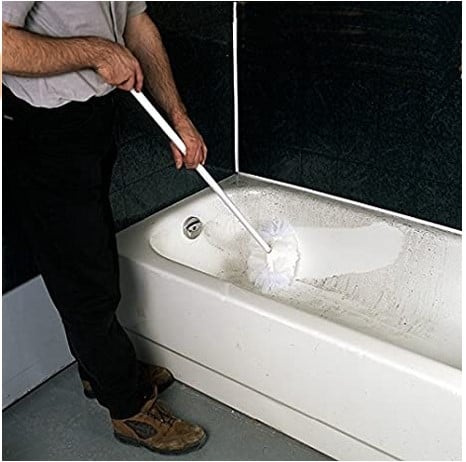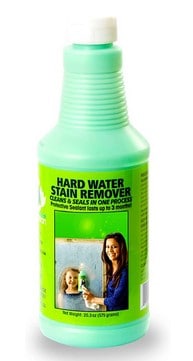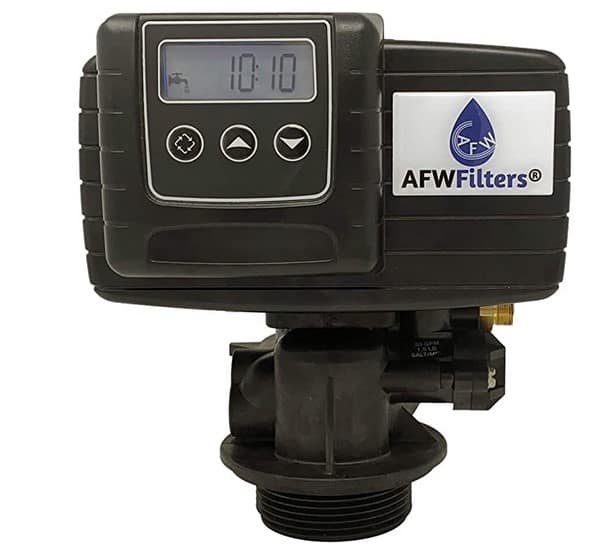How To Remove Brown Stains From Enamel Bath (6 Easy Ways!)
Enamel tubs are stunning when spotless. They add a touch of class to your bathroom, enviable by everyone who sees it. The problem is that the once-gorgeous tub may look unsightly if it starts staining, and that’s why knowing how to remove brown stains from the enamel bath is essential.
It starts with applying a cleanser such as diluted white vinegar, diluted bleach, lemon juice mixture, or commercial cleaner to the stain and allowing it to act for a while. Then, use a soft brush, sponge, or microfiber cloth to wipe the stain off and rinse with warm water.
Once you do that, the brown stain should be a thing of the past. There’s a caveat; you must continue cleaning your enamel bathtub with dish soap and warm water daily or preferably after every bath to avoid the brown staining.
I’ll share the exact steps to follow and expound more on the above-highlighted steps.
Overall, you can opt to use household cleaners or buy a commercial cleaner, as you’ll discover. It all depends on what works for you, but my job is to present both options.
Let’s get started!

How to Remove Brown Stains from Enamel Bath at Home?
There are many ways to get rid of brown stains from your enamel bathtub, but I will describe six. They include:
1. Diluted White Vinegar
White vinegar is a powerful cleaner that removes stains on just about any surface. But since we are talking about enamel surfaces, you should dilute it first.
Here’s how to go about the cleaning:
- Mix white vinegar and clean water in equal parts
- Then dip a sponge, microfiber cloth, or any other soft cloth into the diluted vinegar solution
- Rub the stain with the damp cloth and allow the solution to dissolve the brown stain for about 15 minutes
- Rinse off the vinegar with warm water and leave the tub to dry
2. Diluted Bleach Solution
Bleach can be corrosive. So, you shouldn’t pour it directly onto your enamel bathtub surface. Instead, you should dilute it and use it to wipe the stain off.
Here are the basic steps following it:
- Mix 1 cup of bleach in 1-gallon water to make a dilute bleach solution
- Apply the solution to the stains and wait for about 15 minutes for the bleach to dissolve the stain
- Lightly scrub the paint stain off using a soft cloth or sponge
- Rinse off the stain with warm water and leave the tub to dry
3. Castile Soap + Essential Oils
How about you make your own home multi-purpose bath cleaner? All it takes are castile soap, baking soda, and essential oils.
The two make the perfect cleaner for different types of bathtub stains, and you can also use them to clean the sink and other surfaces spotless.
Here’s how to go about it:
- Mix essential oils, baking soda, and Castile liquid soap in a spray bottle in equal parts
- Spray the mixture to the stain and leave it to act for about 15 minutes
- Gently rub the brown stain off using a soft cloth or sponge
- Rinse it off with warm water
Remember, essential oils have disinfectant properties, whereas castile soap and baking soda are natural cleaners.
4. Hydrogen Peroxide + Baking Soda
If you don’t have castile soap and essential oils, you can substitute them with hydrogen peroxide. Hydrogen peroxide is powerful against stubborn stains and enjoys disinfectant properties.
It’s just that it’s more effective when used with baking soda or tartar cream.
Here’s how to go about it:
- Mix hydrogen peroxide with baking soda at a ratio of 1:2
- Apply the paste to the stain and allow it to act for 30-60 minutes
- Use a sponge, soft brush, or microfiber towel to rub the stain off
- Rinse the tub with warm water and allow it to dry
5. Salt + Lemon Juice
Using common salt and lemon juice, you can also restore your tub to its original spotless self. The two combine well to make the best tub stain remover that doesn’t corrode your tub.
Here’s how to go about it:
- First, cover the brown stains with salt
- Then squeeze lemon on top for the juice to cover the salt
- Use a sponge or microfiber cloth to scrub the mixture
- If the stain doesn’t go away, reapply the paste mixture and give it 30-60 minutes to act
- Rinse off the tub with warm water and wipe it dry
6. Commercial Cleaners
If you don’t want to go through the hustle of making a home cleaner, you can buy a ready-to-apply option and use it to clean your discolored tub.
Just ensure you go for a biodegradable, easy to apply, and non-toxic option like Bio-Clean Hard Water Stain Remover. This commercial cleaner removes stubborn stains and rust on a variety of surfaces.

Why Brown Stains form on Enamel Bath
Now that you know how to remove brown stains, let’s discuss why the stains form in the first place. Generally, your enamel bathtub is staining brown because of any of these five reasons:
a) Soap Scum
If you leave soap scum on the bathtub every time you bathe, the scum may dry and cause a slight discoloration on the tub surface.
The slight discoloration eventually complicates and becomes a tough brownish stain that you cannot remove easily with water and soap.
In most cases, soap scum forms when using hard water. Overall, if you soften your water, you won’t have to worry about soap scum. Alternatively, consider using liquid body wash if you use hard water for bathing.
Or yet, ensure you softly scrub the soap scum away after every wash, and you can do it with borax.
b) Fungi
The bath is humid, which means there is always the risk of fungi growing on the side, especially mildew. That’s more likely to happen if your bathroom rarely receives enough sunshine.
While you can get rid of mildew stains with bleach-based cleaners, too much bleach can scratch enamel, thus not advisable. So, the best approach would be to encourage sunning and aeration to reduce humidity.
c)Strong Cleaners
Some strong chemical cleaners could stain your enamel bathtub. Sodium hydroxide-based cleaners, for example, corrodes the enamel surface, giving it an unsightly brown appearance.
The same goes for chlorine bleaches, acid-based cleaners, and other abrasive cleaners. If you have to use chlorine bleach, it’s advisable to dilute it first before applying it to reduce its corrosiveness.
d) Limescale
Let’s now talk about hard water. Using hard water to bathe leaves behind mineral deposits (limescale) with a brownish or orange appearance.
Over time, the limescale appears like rust on your bathtub, making it look hideous. While you can use vinegar and chemical cleaners to get rid of limescale staining, you can prevent the problem in the first place by softening your water.
Remember, soft water does more than prevent tub staining. It doesn’t damage your plumbing work, saves on the use of soap as it lathers easily, and cleans better since it doesn’t leave residues.
So, how do you soften your domestic water? The easy fix is to install a home water softener such as the Water Boss 36,400 Grain Water Softener System (View on Amazon).
This water softener softens about 90 grains/gallons and generally takes 26 minutes to soften everything. It comes with a 36,400-grain capacity, which is super impressive, and its installation is usually DIY.

e) Tannins
Sometimes, organic matter in the form of tannins finds its way into your water supply. Though tannin is non-toxic, it can stain not just your tub but also laundry.
It even leaves an aftertaste in your drinking water, making it undrinkable. Luckily, you can remove tannins with a tannin filter like.
How to Avoid Brown Stains from Enamel Bath?
After looking at how to remove brown stains from enamel bath and what causes it, we can discuss prevention. Generally, here are the steps to avoid brown stains on your enamel bathtub:
1. Regular Cleaning
Not cleaning your bathtub regularly only encourages staining by soap scum and mildew growth. So, if you don’t want to deal with brown stains in the future, keep the tub clean. All it takes are these supplies:
- Warm water
- Dishwashing soap
- Microfiber cloth, sponge, or soft bristle cleaning brush
Once you have the supplies follow these steps to clean your tub regularly:
- Put two tablespoonfuls of dishwashing liquid in 1 gallon of warm water and mix
- Use a microfiber cloth or sponge to apply the soapy solution onto the tub
- Use the same cloth or sponge or a soft bristle cleaning brush to gently rub the tub to get rid of soap scum and other deposits
- Use room temperature water to rinse the soap off
- Allow your tub to dry before using it again
2. Use Soft Water
As earlier discussed, hard water leaves behind limescale and encourages soap scum. Thus, if you can avoid it, you can evade the two leading causes of bathtub staining.
So, consider using a home water softener system to soften your entire household water. Preferably, go for a water softener with a built-in filter system like the AFWFilter Built Fleck 48,000 Water Softener System (View on Amazon).
This water softener comes with a digital meter valve that allows you to program its operation. It promises to remove all hard water ions and extend the life of your pipes. Its capacity is 48,000 grains, which is just amazing.

People Also Ask (About Removing Brown Stains on Enamel Bath)
1. How do you get brown stains out of a porcelain tub?
You can get brown stains out of a porcelain tub in several ways involving covering the stain with a cleaner, allowing it to act, and then rubbing and rinsing it off.
The cleaners could be any of these:
- Dilute bleach
- Dilute white vinegar
- Lemon juice table salt mixture
- Commercial cleaners
2. How do you fix a discolored bathtub?
You can fix a discolored bathtub by cleaning it with a dilute vinegar solution. You need to wipe the stain with a mixture of white vinegar and water at a ratio of 1:1.
If the stain doesn’t go away, consider allowing the diluted vinegar solution to act for some time before scrubbing it off.
3. What causes brown stains in a bath tub?
The brown stains in your bathtub are normally caused by what’s contained in the water. The most common types of stains are reddish-brown stains.
These stains are caused by dissolved iron in the water. Once the iron is exposed to air, it forms an iron oxide that gives it a reddish-brown color.
4. What causes rust stains in the bathtub?
Most rust stains are caused by the presence of dissolved iron in the water. To create an unsightly orange-red stain the iron oxidizes and collects on the surface.
5. What do you clean an enamel bath with?
To clean your enamel bath you need 1 gallon of hot water and 2 tablespoons of dishwashing soap. To clean, dip a sponge or small rag into the soap mixture and scrub the sink or tub. Once you are done rinse well.
6. How do I clean a dirty bathtub?
Add parts of vinegar and dish soap to the spray bottle, shake and spray on it. Once you spray down your entire bathtub, allow the solution to work for about 10 minutes. You can then use a sponge or brush to clean that layer of filth.
7. How do I know if my bathtub is enamel or porcelain?
The best way to determine whether you are dealing with enamel or porcelain is by carrying out a simple test. You can use a magnet and if it sticks its enamel if not its porcelain
8. Can bleach damage a bathtub?
Since bleach is highly corrosive it can badly damage your skin. So, always wear gloves while working with household bleach. If you pour undiluted bleach directly onto the bathtub you may permanently discolor the enamel or other material.
Summary on how to remove brown stains from enamel bath!
While enamel tubs are known for their durability and shine, it will take you a little effort to maintain them. You can use some store cleaners but be careful so they don’t damage the finish.
Interestingly, you can find some of the most effective cleaners right at home. So that’s how to remove brown stains from enamel baths.
Also Read:
Let Us Know How We’re Doing!
Did this expertly prepared resource answer your question?
Do you have another question about home maintenance, home improvement projects, home appliance repair, or something else?
Get more information, send in questions and keep the discussion going by contacting the I’ll Just Fix It Myself company customer service team at at 1-800-928-1490 or Email us at [email protected]
